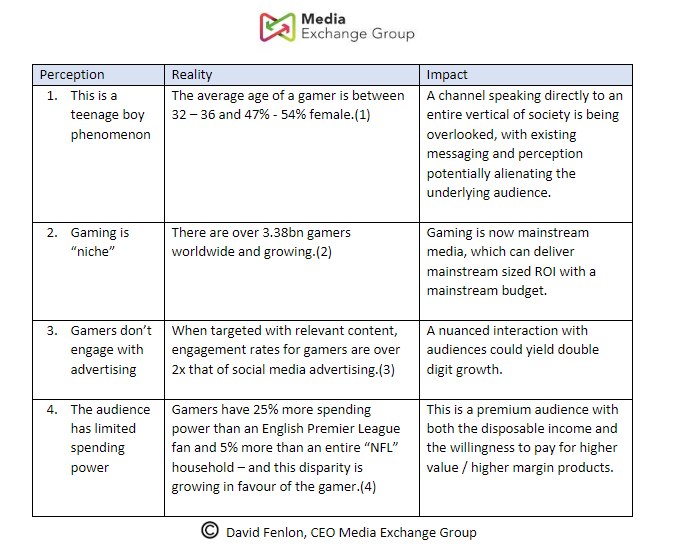The future of brand growth will come from Gaming Advertising
13th March 2024 by David Fenlon
Brands and Agencies need Gaming Advertising in their media plans or risk being left behind
Gaming audiences, stereotypes vs. reality
In the world of advertising, “gaming” has recently become an area of interest for brands, although there is little information readily available to them. The most recent Cannes Lions festival featured only a handful of presentations / panels on gaming, with only one in the entire festival on esports (competitive video gaming). The creation of Cannes Lions’ new “gaming” advertising award speaks to the potential of the channel, but despite this, there is a dearth of educational material for budget holders, resulting in a lack of understanding of the landscape. Consequently, few budgets have flowed to this advertising area.
This is a mistake. Gaming is no longer a niche area and the perception of audience profiles is woefully inaccurate. This is hardly surprising: everything we have been told about “gamers” is simply incorrect. Consequently, advertisers brush over this audience and miss the associated opportunities – this is a big, brewing problem for brands and agencies alike. The perception vs. the reality of this demographic is wildly divergent, as demonstrated below:

The perceived v. actual demographic disparity outlined here is shocking enough, but doesn’t yet reveal the full picture. The average age of gamers continues to climb gradually towards later 30s, but this is not due to younger generations dropping off in interest. If anything, it is the opposite. Generation Alpha (those up to 13) trend towards foregoing social media entirely, as all their social needs are met by gaming and they find the community significantly less toxic than social media platforms. The fact that gamers are still “aging” means that the category is drawing in much older audiences as well whilst, crucially, retaining their existing audiences. This is an enormous shift in the media landscape, and if the current behavior of younger generations is anything to go by, an integral shift to the future of brand advertising.
Why gaming matters and how to be lucrative in the market
48% - 55% of audiences under the age of 40 use ad blockers.(5) They are also moving into walled gardens / echo chambers where advertising is impossible, or simply scrolled over. Gaming and its components represent one of the few avenues for brands to advertise to these effectively. It has become increasingly accessible due to advances in technology (especially mobile); and is significantly more engaging than most tradition forms of media.(6) Its variety and rich content base also provides flexibility in the message being delivered, allowing brands to cut through to audiences. This combined with the digital community nature of the audience means that reactions to successful campaigns are much quicker and far more lucrative than traditional campaigns.
Gaming audiences spend big and react rapidly to campaigns that are still highly cost-effective
Consequently, “niche” messages can be scaled over huge audiences and can be considered authentic – take Gucci, for instance. Through a progressive set of campaigns from brand insertion into Minecraft to advertising via Fnatic (a premier esports team) and partnering with the esports tournament operator FACEIT, Gucci is now one of the most widely recognized fashion brands in gaming. Commercially, this has meant that Gucci has been able to sell gaming related products at a much higher price and at monster margins – their Fnatic branded watch sold for $1,600,(7) and their Gucci Xbox sold out at $10,000 – the latter before it even got to market.(8) Gucci simply would not have been able to take on such a dominant position in traditional areas of advertising, nor could they demand such high prices.
More modest campaigns can also result in impressive results. DXRacer, a gaming chair brand, recently returned over 20 times the media value of their spend when sponsoring the Bali DOTA 2 major, and the Indonesian Minister for Sport posted on their Instagram a picture of the chairs now being a mainstay in his office.(9) This sort of exposure is now almost impossible through most other channels, regardless of budget size.
Why is now a good time?
Despite a few notable campaigns, the landscape is relatively untouched by brands and advertising. This means that cut-through of message to audiences is extremely high for advertisers, and the number of novel and innovative options open to brands is large. Equally, the cost of advertising in this area is a small fraction of the equivalent on Paid Social or traditional sporting sponsorships.
However, this is changing. Fashion, apparel, automotive, and FMCG brands and their agencies are starting to take gamers seriously. They are hiring gaming roles, gradually diverting more and more budget to this area. The plus side is that many of the potential pitfalls have been identified and mitigated by the trailblazers. Against this backdrop, brands have an enormous opportunity to gain double digit growth if they can mobilize quickly and effectively. Those who don’t will either have to pay an enormous premium in years to come or will be left behind by their competitors, closed out of the next generation of customers.
References
(1) Circana PlayerPulse June 2023
(2) 2023 Newzoo Global Games Market Report (3) https://www.socialinsider.io/b...; combined with https://www.upfluence.com/infl....
(4) analysis of gamescape, NFL and EPL figures
(5) https://www.iab.com/wp-content...
(6) https://www.activisionblizzard...
(7) https://www.thedrum.com/news/2...